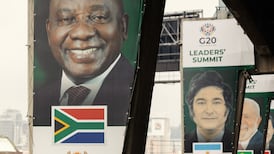In 1986, Denmark told the United Nations it should set up “refugee-processing centres” in parts of the world where many refugees were on the move.
The first priority should be “voluntary repatriation” of refugees to their home countries, the Danes argued. The next option should be local resettlement and, as a very last option, transfer to places such as Denmark. Each UN member state could choose the number of refugees it would be willing to take.
The idea was shot down. It foundered again in 2003, when Denmark pursued it jointly with Britain. Last year, courts found it contrary to international law when it resurfaced as the former UK Conservative government’s since-abandoned “Rwanda plan”.
Nevertheless, this and other ideas pioneered by Denmark have gained increasing momentum across Europe and are the inspiration for tough new plans laid out this week by the government of Keir Starmer in Britain.
READ MORE
It’s quite a turnaround from 2021, when Denmark was the subject of widespread international criticism and a European Commission spokesman said its plan for overseas asylum centres was “undermining the foundations of the international protection system for the world’s refugees”.

Copenhagen has a sense of vindication. Prime minister Mette Frederiksen told the European Parliament this summer that politicians were “finally” adopting ideas that have been “mainstream among our populations” for years.
As leader of the Social Democrats, Frederiksen led the centre-left party to harden its immigration policies to attract an electorate usually catered to by the right, even at the cost of losing some of its voters to more cautious parties on the left.
“Denmark should be able to decide for itself how many non-western foreigners we want to accept,” her 2018 manifesto promised.
“We will establish a reception centre outside Europe ... It must no longer be possible to seek spontaneous asylum in Denmark.”
Eight years on, such a reception centre is yet to exist.
Establishing one faces the same problems as it did in 1986: countries in the developing world are no more eager to host asylum seekers than the northern countries that are trying to get rid of them.
In addition, the proposal frequently runs up against the concept of non-refoulement. Under international treaties agreed after the second World War, people cannot be returned to places where they might face torture or ill-treatment.
Nevertheless, the idea is catching on in a new, evolved form.
Overseas centres are now conceived as a way to get rid of asylum seekers who have already been rejected, rather than a place to accommodate applicants while they are processed.
This is seen as a solution to the difficulty of deporting people if they don’t co-operate, or if their own countries refuse to take them back.
The European Commission proposed setting such “return hubs” as a joint EU project earlier this year.
Some countries are already forging ahead on their own.
Italy signed a €670 million deal with Albania last year to build two accommodation centres there.
Initially intended as a processing centre for migrants rescued on the Mediterranean, the centres are now being reconceived as a place to send rejected applicants in the wake of court challenges.
The Netherlands announced it had signed a deal with Uganda in September to trial a system whereby rejected asylum seekers would be sent to a “reception location” in Uganda.
[ ‘Grave concerns’ over rights for asylum seekers under EU migration pactOpens in new window ]
“From there they will be expected to return to their country of origin,” the Dutch government said.
This week, the Greek government said it was pursuing a joint deal with Germany to find an African country to take rejected asylum seekers.
It is intended to act as “a deterrent” to asylum seekers, migration minister Thanos Plevris told Greek media.
“Imagine taking an Egyptian and sending him to Uganda,” he said.
Denmark is also a pioneer in the strategy of airing hardline ideas as a communications strategy to dissuade potential asylum seekers, even if they won’t end up being put into practice.
In 2015, the Danish government ran advertisements in Lebanese newspapers announcing that a new law would allow authorities to seize valuables from asylum seekers at the border, as recompense for the cost of their accommodation.
The so-called “jewellery law” was intended to dissuade potential Syrian refugees from travelling onward to Denmark. Danish government figures suggest it has been used rarely, and some years not at all.
Seizing assets of asylum seekers is one of a range of Danish measures the UK government now says it hopes to emulate, along with making refugee status temporary so that it only lasts as long as their home countries are still dangerous.
The British government also says it will make support for asylum seekers discretionary rather than automatic, saying it can do so as it is no longer bound by an EU law which Denmark, because it has an opt-out, never had to follow.
That law was intended to standardise conditions, procedures and rights for asylum seekers so that they wouldn’t try to travel between EU countries in search of more favourable conditions.
The alternative to having minimum standards, supporters of the law said at the time, is a “race to the bottom” as each country competes to seem less attractive to refugees.
Is the race now on?




















